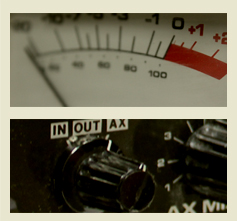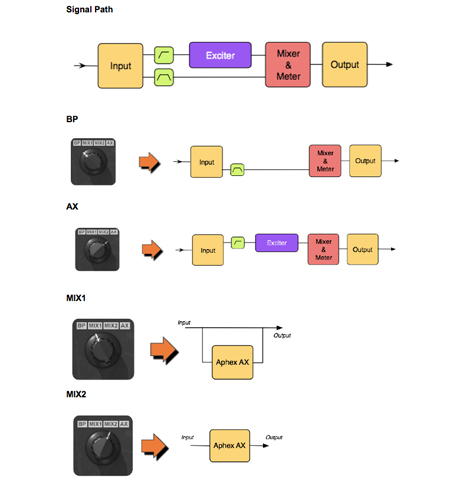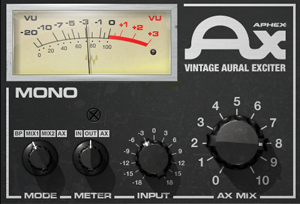Review: Waves Aphex Vintage Aural Exciter by Zach McNees
Who couldn’t use some clarity these days? Honestly. When I was first asked to review the Waves Vintage Aural Exciter, I remembered my first days in the recording studio using the modern hardware version of the Aphex Aural Exciter – the Type C2 with big bottom.
The original and rare vintage tube processor enhanced dull and lifeless tracks with vibrancy, brightness and, of course, clarity. If the plug-in version was anything like the original, I had to have it.
TECH SPECS: The Waves Aphex Vintage Aural exciter is available in TDM, RTAS, Audio Suite, VST and AU format for PC or MAC. Mono and stereo components and support for up to 24bit/192khz resolution are standard. The plug-in comes standard in Waves flagship Mercury bundle and is also available in TDM and Native a la carte for $250 USD.
WHAT IT DOES: Aural Excitement! Waves’ Aphex Vintage Aural Exciter is a faithful reproduction of the original Aphex Aural Exciter used by countless engineers and producers to enhance brightness, presence and overall brightness and vibrancy on instruments and vocal tracks.
THE INTERFACE: The design of the plug-in is bold and straightforward with no guesswork needed. Controls for MODE, METER, INPUT, AX MIX and OUTPUT are all easy to access and large enough to be able to tell what you’re controlling quickly. There’s also an additional section called ANALOG for Waves analog noise modeling and characteristics caused by hum based on power.
IN USE: Where most plug-ins these days are designed to serve a multitude of purposes, the AX is unique in that it really serves one singular function.
On the surface the unit looks fairly straightforward with three basic modes (MIX1, MIX2 and AX) along with bypass. The main control is the AX MIX knob along with standard INPUT and OUTPUT knobs.
First, let me offer a quick explanation of the modes of the AX: Mix 1 essentially is an insert version of the AX’s send/return sound. A visual diagram of this shows equal amounts of dry unaffected signal and wet signal passing through the unit. Mix 2 is the AX’s classic mix mode sound, which passes the entire signal through the unit and allows the user to adjust the amount of effect audible with the AX mix knob. AX mode is used for aux send and return scenarios. This disables the AX mix knob as 100% of the effected signal is passed through the unit allowing the user to blend the sound with the send and return. Confused yet? I was!
A very helpful explanation and diagram (shown below) is included in the plug-in manual and helps alleviate much of the confusion between modes. As with any piece of gear, the best way to learn is to turn the knobs and use your ears!
Mix 1 is the setting I found myself using the most when using the AX as an insert. This setting allows you to judiciously inject any amount of brightness and clarity into your sound source without any noticeable filtering or problematic frequency response modulation.
On a recent track for the children’s album series “People Rock! Vol. 1” the AX was the perfect solution for electric guitars that were sounding a little too warm and dull but not really taking well to specific EQ treatment. The AX does an almost magical job at adding subtle bite and overall presence to guitars. These same properties can be applied really to almost any sound source in need of a sonic facelift. Vocals, piano, snare and even bass DI took really well to the AX in MIX 1.
Mix 2 as described in the included user manual has “unique phase behavior” resulting in “modulations in frequency response occurring at certain AX MIX settings in MIX2 mode. Mix settings of 1 to 4.5 are subtle, 4.5 to 7.2 results in a frequency dip and settings from 7.2 to 10 bring about a pretty, not subtle sound.” I was pleasantly surprised to find this description in the manual for the MIX2 setting as this was precisely what I was finding in my own tests.
Above 7.2 the changes are absolutely very noticeable. On vocals, the frequency bumps were loosely comparable to an EQ with 5 to 6dB bumps at 1.2K, 3K and 10K.
I was honestly not thrilled about the modulations to the sound and the dip in the middle frequency range, as any processor that tends to noticeably filter or change the overall sound of my tracks tends to be something I stay away from – unless I’m really trying to alter the original source. Although I’m sure there are applicable uses for Mix 2, I had trouble finding anything during the course of mixing that I thought sounded better here than in Mix 1.
AX Mode is absolute gold on drums. I tend to do a lot of subtle parallel bus compression from aux sends and the Aural Exciter is an excellent addition in that arsenal. I set up aux sends at unity sending off all of my kick and snare faders into the Aural Exciter in AX mode and blended the return very slightly with the dry drum bus.
The results really are stunning, adding crispness to the kicks and snares and giving the whole kit a lifted sense of space. Certainly a great deal of intense listening and A/Bing needed, as it’s very easy to use too much of the AX signal, but the payoff is well worth the time spent to get it right.
I haven’t really addressed the analog modeling section here as it’s standard across a wide range of Waves’ current plug-ins. The effects of this section are extremely subtle if not unperceivable in a mix. I guess I haven’t yet found a good reason to add noise or hum back into my tracks!
TO BE CRITICAL: I’m not crazy about the default settings where the AX mix is cranked up and the output is -3dB. The default setting immediately makes anything it’s inserted on sound slightly phasey and shrill, which is not a good first impression out of the gate – my preference is for default settings that don’t affect my sound source, so that I can decide how drastically I want to alter the sound.
It’s also a bit disconcerting that Mix 2 creates “modulations in frequency” without any hard data as to what kind of frequency modulations are occurring – perhaps that can be clarified by Waves in future updates. [To this point, Waves responded “this is exactly what the hardware does – and that’s the main reason we have this mode as is.”]
WRAPPING UP: When the AX works on my tracks, it works brilliantly. Over the course of my tests on various instruments and sound sources, I found that the Aural Exciter really enhanced the track about half of the time. And I suspect the main reason for this is that I simply don’t find myself mixing a great deal of material that’s in need of additional brightness and vibrancy.
During the original Aural Exciter’s heyday, the use of tape machines and tube mics resulted in a warm and smooth sound that often benefited from the AX’s ability to provide additional vibrancy and brightness. These days, solid state mics and DAWs are more standard which, in general, results in tracks that are brighter and less saturated and therefore have less use for boxes like the AX that serve only to supplement more top end and clarity.
But at $250, Waves’ Aphex Vintage Aural Exciter is well worth the investment — when you do need that clarity, this is your plug-in.
To demo or purchase, go to: http://www.waves.com.
Zach McNees is a Brooklyn-based producer/engineer/mixer and live recordist who’s worked with Bjork, Rob Thomas, The Gregory Brothers, Pixies, Liars and Alice Cooper. Get in touch with Zach via http://www.zachmcnees.com.










